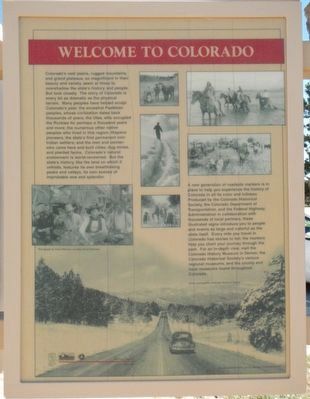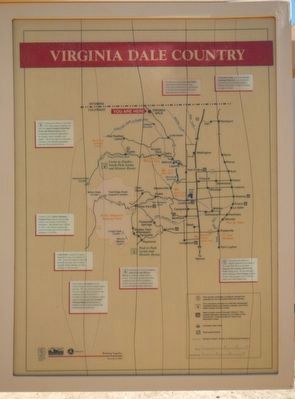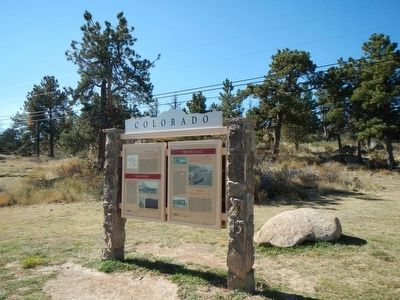Near Livermore in Larimer County, Colorado — The American Mountains (Southwest)
Virginia Dale
Trails West
— Welcome To Colorado —
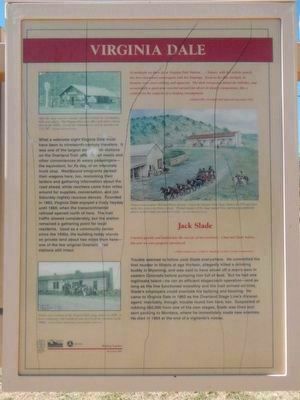
Photographed By Barry Swackhamer, September 8, 2015
1. Virginia Dale Marker
Captions: (top left) After the stage station's closure, ranchers settled the surrounding hills and valleys. The Virginia Dale post office and store - shown here in the 1940s - served the community as well as travelers on U.S. 287.; (bottom left) Visitors pose in front of the Virginia Dale stage station in 1939. A local community club stabilized and preserved the structure in the 1990s.; (Upper right) Famed photographer William Henry Jackson visited the Virginia Dale Stage Station in 1870 and later made this watercolor from a photo. Though images of the stage station have survived, no definitive photos of Jack Slade are known to exist.
At midnight we drew up at Virginia Dale Station ... Nature, with her artistic pencil, has here been most extravagant with her linings. Even in the dim starlight, its beauties were most striking and apparent. The dark evergreen dotted the hillsides, and occasionally a giant pine towered upward far above its dwarfy companions, like a sentinel on the outpost of a sleeping encampment. - Edward Bliss, Overland Trail stagecoach passenger, 1862
I turned quickly and looked into the muzzle of two revolvers. I had met Slade before, but now were properly introduced - 1880s reminiscence, Frank G. Bartholf, Larimer County commissioner
Trouble seemed to follow Jack Slade everywhere. He committed his first murder in Illinois at age thirteen, allegedly killed a drinking buddy in Wyoming, and was said to have sliced off a man's ears in Eastern Colorado before pumping him full of lead. But he had one legitimate talent - he ran an efficient stagecoach operation - and as long as the line functioned smoothly and the mail arrived on time, Slade's employers could overlook his bullying and boozing. He came to Virginia Dale in 1862 as the Overland Stage Line's division agent; inevitable, though, trouble found him here, too. Suspected of robbing $60,000 from one of his own stages, Slade was fired and sent packing to Montana, where he immediately made new enemies. He died in 1864 at the end of a vigilante's noose.
We set out from this place (the Cache la Poudre) without road, trail, or guide through the plains, and hills. We succeeded well, from 15 to 20 miles a day, for some time until we got within some 40 to 50 miles of the North Fork of the Platte, when the
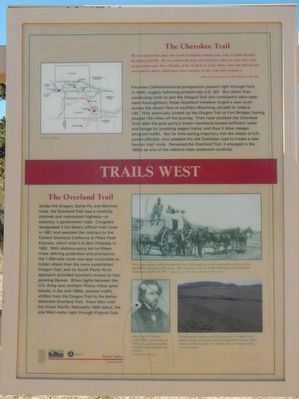
Photographed By Barry Swackhamer, September 8, 2015
2. Trails West Marker
Captions: (top left) (Map of the Cherokee Trail); (group of 3 at the bottom right) (top) Most stagecoaches could accommodate up to nine passengers, not counting the driver or those unfortunate enough to ride on top. Here men pose with one of Ben Holladay's Overland Stage Company's coaches in 1867.; (bottom left) John C. Fremont explored this area during an 1843 expedition blazing the trail for later emigrants and travelers,; (bottom right) Throughout the summer and fall during the Overland Trail's heyday, dozens of wagons moved through here each day, their wheels carving ruts that can still be seen near Virginia Dale.
Fourteen California-bound prospectors passed right through here in 1849, roughly following present-day U.S. 287. But rather than continuing north to join the Oregon Trail (the continent's main east-west thoroughfare), these impatient travelers forged a new route across the desert flats of southern Wyoming, parallel to today's I-80. They eventually picked up the Oregon Trail at Fort Bridger, having shaved 150 miles of the journey. Their road (dubbed the Cherokee Trail, after the gold party's Indian members) lacked sufficient water and forage for plodding wagon trains, and thus it drew meager emigrant traffic. But its time-saving trajectory met the needs of U.S. postal officials, who adapted the old Cherokee road to create a new frontier mail route. Renamed the Overland Trail, it emerged in the 1860s as one of the nation's main westward conduits.
Unlike the Oregon, Santa Fe, and Mormon trails, the Overland Trail was carefully planned and maintained highway - in essence, a government road. Congress designated it the West's official mail route in 1861 and awarded the contract to the Central Overland California & Pikes Peak Express, which sold it to Ben Holladay in 1862. With stations every ten to fifteen miles offering protection and provisions, the 1,900-mile route was less vulnerable to Indian attack than the more established Oregon Trail, and its South Platte River approach provided excellent access to fast-growing Denver. When fights between the U.S. Army and northern Plains tribes grew bloody in the mid-1860s, pioneer traffic shifted from the Oregon Trail to the better-defended Overland Trail. From then until the Union Pacific Railroad's 1869 debut, the way West came right through Virginia Dale.
Colorado's vast plains, rugged mountains, and grand plateaus, so magnificent in their beauty and variety, seem at times to overshadow the state's history and people. But look closely. The story of Colorado is every bit as dramatic as the physical terrain. Many people have helped sculpt Colorado's past: the ancestral Puebloan people, whose civilization dates back thousands of years; the Utes, who occupied the Rockies for perhaps a thousand years and more; the numerous other native people who lived in this region; Hispano pioneers, the state's first permanent non-Indian settlers; and the men and women who came here and built cities, dug mines, and planted farms. Colorado's natural endowment in world-renowned. But the state's history, like the land on which it unfolds, features its own
breathtaking peaks and valleys, its own scenes of improbable awe and splendor.
A new generation of roadside markers is in place to help you experience the history of Colorado in all its color and fullness. Produced by the Colorado Historical Society, the Colorado Department of Transportation, and the Federal Highway Administration in collaboration with thousands of local partners, these illustrated signs introduce you to people and events as large colorful as the state itself. Every miles you travel in Colorado has stories to tell; the markers help you chart your journey through the past. For an in-depth view, visit the Colorado History Museum in Denver, the Colorado Historical Society's various regional museums, and the county and local museums found throughout Colorado.
Erected 2003 by Colorado Historical Society, Colorado Department of Transportation and Federal Highway Administration. (Marker Number 244.)
Topics and series. This historical marker is listed in these topic lists: Roads & Vehicles • Settlements & Settlers. In addition, it is included in the Colorado - History Colorado, and the Overland Trail series lists. A significant historical year for this entry is 1862.
Location. 40° 58.847′ N, 105° 23.599′ W. Marker is near Livermore, Colorado, in Larimer County. Marker is on U.S. 287 near High Lonesome Road, on the left when traveling north. Touch for map. Marker is at or near this postal address: 35083 USHighway 287, Livermore CO 80536, United States of America. Touch for directions.
Other nearby markers. At least 8 other markers are within 11 miles of this marker, measured as the crow flies. The Overland Stage Line (approx. 1˝ miles away in Wyoming); a different marker also named Virginia Dale (approx. 2.6 miles away); Pyramid on the Plains (approx. 10.4 miles away in Wyoming); The Transcontinental Railroad (approx. 10.4 miles away in Wyoming); Ames Monument (approx. 10.4 miles away in Wyoming); Old Sherman Cemetery (approx. 10.7 miles away in Wyoming); Lonetree on the Laramie Range (approx. 10.8 miles away in Wyoming); Tree in the Rock (approx. 10.8 miles away in Wyoming).
Credits. This page was last revised on June 16, 2016. It was originally submitted on October 14, 2015, by Barry Swackhamer of Brentwood, California. This page has been viewed 810 times since then and 67 times this year. Photos: 1, 2, 3, 4, 5. submitted on October 14, 2015, by Barry Swackhamer of Brentwood, California.
